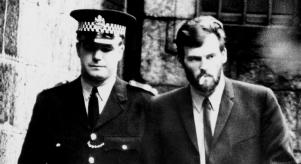
Germany's most prolific serial killers
Despite being a large country with many sizeable urban areas, Germany is a very ordered place with a rather low crime rate. As with anywhere though, scratch beneath the surface of this very civilised society and there’s horror abound.
Germany has had to endure its fair share of twisted serial killers in its time.
Niels Högel - 85 victims
We begin with the killer with the highest count of victims. When you see that a murderer has claimed the lives of 85 people, most true crime aficionados will assume one thing: that the killer was an ‘angel of death’.
85 is a staggeringly high number. But that’s just the number of victims that Niels Högel was found guilty of killing. The true number of patients that this former nurse murdered is thought to be as many as 300.
The Lower Saxony-born Högel qualified as a nurse in 1999 and wasted no time embarking on his killing spree. By 2001, his employers at the Oldenburg Clinic had already noticed an unusual spike in deaths and resuscitations. These trends were noticed for years but Högel wasn’t identified as the cause until 2005, when he was caught red-handed fiddling with a patient’s syringe drip.
An investigation soon uncovered the extent of the man’s crimes, committed against vulnerable, ill and elderly hospital patients across a number of institutions in which he worked. He was arrested and, after trial, sentenced to life in prison.
Karl Denke - 30 victims
'The Cannibal of Ziębice' operated in the interwar period of the 20th century, killing - at the very least - 30 people, many of whom he was believed to have eaten some part of. Denke's victim profile was unusually non-specific. He didn't favour men or women and wasn't bothered by age. His main preference was merely that they were vagrants or simply the sort of person who had fallen by the wayside of life and unlikely to be noticed if they went missing.
Denke stalked his victims, cornering them and beating them to death with an axe handle before cutting them up. When police eventually identified the killer and attended Denke's house, they found various body parts and a number of jars stuffed full of human flesh and curing salts or pickling vinegar. Further investigation led police to believe that the newly-arrested serial killer wasn't the only person who ate the meat that Denke sourced. He had, it seemed, been selling it at a nearby market and passing it off as pork.
Stephan Letter – 29 victims
The number of similarities between Stephan Letter and Niels Högel are stark. Both were prolific serial killers who worked as nurses and were liked by colleagues and patients alike.
Letter drugged and killed patients at a hospital in Sonthofen, Bavaria between January 2003 and July 2004. He was later found guilty of 16 counts of murder, 12 counts of manslaughter and a single count of killing on request. Yet, while he was charged and sentenced for those 29, many more deaths likely lie on Stephan Letter’s conscience.
The angel of death figure tended to target over 75s and injected them with the paralytic drug Lysthenon, later claiming he was only helping the sick and dying to speed up their journey towards death. This defence falls apart when you leaf through his cases. A good number of his victims were not dying and some were even due to be discharged from hospital shortly before he killed them.
Fritz Haarmann - 24 victims
‘The Butcher of Hanover', also known as 'The Vampire of Hanover', Fritz Haarmann killed during the 1920s, when he lured young men - primarily vagrants and prostitutes - to his home before slaughtering them. He was convicted of 24 murders, but the actual number of his victims was very likely much higher. He was executed by guillotine in 1925.
The case garnered significant attention due to the brutality of his crimes and the sensationalist nature of the media coverage, which sparked debates about mental illness and attitudes around homosexuality at the time.
Haarmann said this on being arrested: ‘I'm not ill — it's only that I occasionally have funny turns. I want to be beheaded. It'll only take a moment, then I'll be at peace.’
Adolf Seefeldt - Number of victims: 12
Adolf Seefeldt was a German serial killer active in the early 20th century. He murdered at least 12 people, including his wife and children, before being apprehended. Seefeldt's crimes shocked Germany, given his victims were mostly young boys asleep in their bedrooms at home. He would sneak in, sexually assault them and then poison them. Because of his modus operandi, he was given the nickname of 'The Sandman'. He was sentenced to death and executed in 1925.
Peter Kürten - Number of victims: 9
Peter 'The Vampire of Düsseldorf' Kürten was a notorious German serial killer who truly terrorised the city back in the early 20th century. He committed a series of gruesome murders, rapes, and mutilations between May 1913 and November 1929.
Kürten confessed to a wide range of crimes, admitting with some frankness to derive sexual pleasure from his shocking acts of extreme violence. Another motive, he claimed, was that he sought some sort of 'vengeance against society'. His spree ended with his arrest in 1931. He was convicted of nine murders and seven attempted murders, though he boasted of plenty more. He was executed by guillotine in 1931.
Friedrich Schumann - Number of victims: 7
Killer of seven, Friedrich Schumann operated in the Berlin district of Spandau between 1918 and 1920. 'The Terror of Falkenhagen Lake', as he was called, was caught in August 1920 and executed by beheading in Plötzensee Prison a year later.
Elisabeth Wiese - Number of victims: 5
The only female serial killer on our list, Elisabeth Wiese was a serial killer who operated in her home city of Hamburg. 'The Angel Maker of St. Pauli' was arrested and convicted in 1903 for poisoning five children. She was executed by guillotine in February 1905.
For context to those of you more familiar with British serial killers, Wiese was effectively the German Amelia Dyer. Both were 'baby farmers' who fostered and adopted unwanted and 'illegitimate' babies, claimed a government grant and then killed and disposed of the poor unfortunate child.










